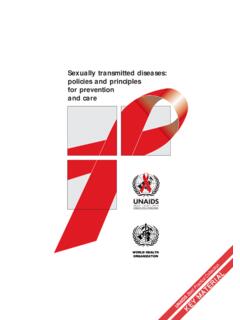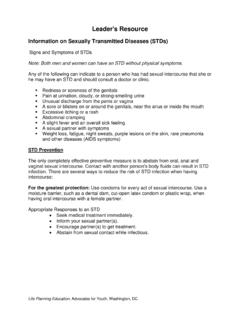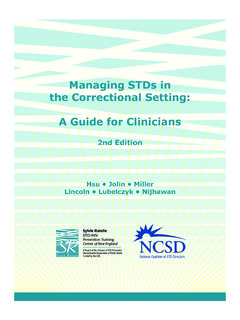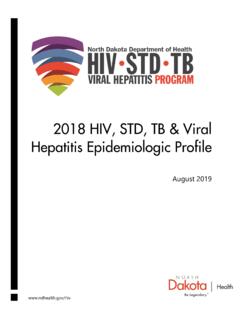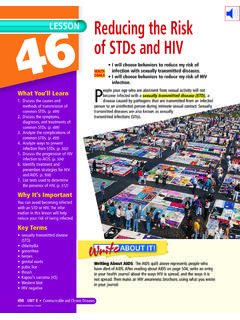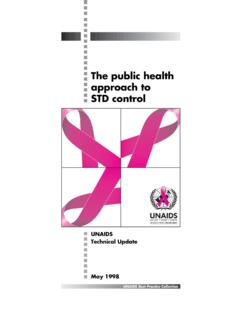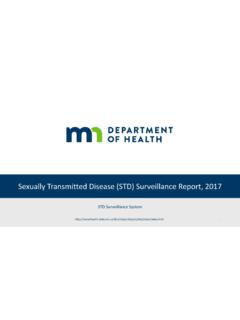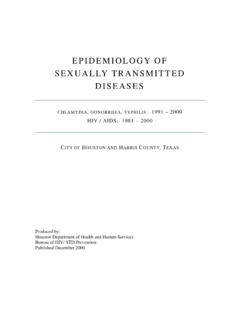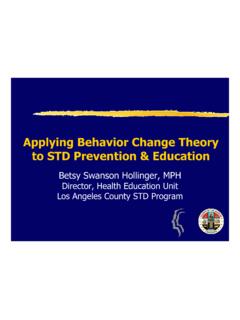Transcription of Sexually Transmitted Infections In Developing …
1 Sexually Transmitted Infections In Developing countries Current concepts and strategies on improving STI prevention, treatment, and control ii iiiTable of Contents Table of Contents .. iii Acronyms and Abbreviations .. iv v Executive Summary .. 1 I. The Global Burden of Sexually Transmitted Infections (STIs) and their 3 A. Overview: The Effects of STIs on Health and Development .. 3 B. STI Infections , Syndromes and Sequelae .. 4 C. Human and financial costs .. 5 D. Prevention and Control of STIs .. 6 E. Curative Treatment and Control of Transmission .. 6 F. Primary Prevention of Chronic Infections and Sequelae of Viral STI .. 7 II. STI Transmission 8 A. Determinants of STI Transmission.
2 8 B. Biologic Factors Affecting STI Transmission .. 9 C. Behavioral Factors Affecting STI Transmission .. 10 D. Social and Environmental Factors Affecting STI Transmission .. 11 E. Special Case: The Interaction between HIV and Other STIs .. 11 III. STI Prevention & Control Strategies .. 12 A. The Basis for Effective STI control -- Treatment is Prevention .. 12 B. Supportive Elements for STI Prevention and Control .. 21 C. Beyond Clinic-Based Care: Expanding STI Control Efforts .. 26 D. Prioritizing Program Delivery Based on Resource 27 IV. Integration of Services .. 28 V. Future STI Prevention Initiatives and Opportunities .. 29 Annex A. Tables .. 34 Annex B. Boxes .. 41 Annex C. Website links.
3 46 Annex D. References .. 47 ivAcronyms and Abbreviations AIDS Acquired Immune Deficiency Syndrome CDC Centers for Disease Control and Prevention DALY Disability-adjusted life year HBV Hepatitis B Vaccine HIV Human Immunodeficiency Virus HPV Human Papillomavirus HSV-2 Herpes Simplex Virus-2 STD Sexually Transmitted disease STI Sexually Transmitted infection USD United States dollars WHO World Health Organization vAcknowledgements This paper was prepared by a team from the Centers for Disease Control and Prevention (CDC) and the World Bank. The team was led by Mary L. Kamb, Division of STD Prevention, CDC and Eve Lackritz, Division of Reproductive Health, CDC.
4 The team consisted of professionals from CDC, including Jennifer Mark, Danielle B. Jackson, Harriet L. Andrews, Cathleen M. Walsh, Thomas L. Gift, and Lesley C. Brooks; as well as from the World Bank, including Rama Lakshminarayanan, Coordinator; Peter A. Gaius-Obaseki, Junior Professional Officer; and Sadia Chowdhury, Senior Health Specialist. The team would like to express their gratitude to the reviewers at the World Bank for their extensive comments and suggestions: F. Ayodeji Akala, Senior Public Health Specialist; Pia Axemo, Senior Health Specialist; Shiyan Chao, Senior Health Economist; Son Nam Nguyen, Senior Health Specialist; Kelechi Ohiri, Health Specialist; and Bert Voetberg, Lead Health Specialist. The team is also grateful to Jessica St. John for providing copyediting, formatting, and printing assistance.
5 The findings and conclusions in this report have not been formally disseminated by the Centers for Disease Control and Prevention and should not be construed to represent any agency determination or policy. 1 Executive Summary The Global Burden of STIs on Health and Development The global burden of Sexually - Transmitted Infections (STIs) to health and development is often overlooked as a public health priority. The majority of STIs worldwide are caused by eight Infections : syphilis, gonorrhea, chlamydia, trichomoniasis, genital herpes, hepatitis B virus (HBV), and human papillomavirus (HPV). These Infections , often silent and without symptoms, can result in serious or fatal health consequences. Cervical cancer, caused by HPV, is the largest single cause of years of life lost to cancer in the Developing world and, because it affects women in their most productive years, has a devastating effect on the well-being of families.
6 Syphilis among pregnant women still results in up to million perinatal deaths each year. Damage to the fallopian tubes from gonorrhea and chlamydia can lead to infertility, as well as tubal pregnancy, an important cause of maternal death in Developing countries . Hepatitis B, most frequently Transmitted from mother-to-child in endemic areas, can result in chronic infection, liver cancer and liver failure. Genital herpes and other genital ulcer diseases increase risk of HIV transmission. STIs are among the world s most common diseases, with an annual incidence exceeded only by diarrheal diseases, malaria, and lower repiratory Infections . The burden on the health care system and healthcare expenditure is great. STIs, even without including HIV, are consistently among the most common conditions leading to health care visits regardless of national resources.
7 Due to their high prevalence, particularly in Developing country settings, STIs result in substantial productivity losses for individuals and communities, particularly where the majority of the population is under 40 years of age. In Developing country settings, STIs are among the leading causes of disability adjusted life years (DALYs) lost for women of reproductive age, exceeded only by maternal causes and HIV. Effective, Affordable Solutions The tragedy of the health and economic burden of STIs is that they are preventable and often treatable, frequently with simple, inexpensive interventions. For example, stillbirths due to syphilis can be prevented with routine screening of pregnant women and treatment with a single injection of penicillin. A number of evidence-based and effective strategies have emerged and become widely accepted over the past two decades: Prevention through Treatment: Prompt identification and treatment of bacterial STIs remains a cornerstone of STI control.
8 Treating STIs reduces prevalence and breaks the chain of transmission in the community, and is therefore the most effective form of prevention in the absence of a vaccine. However, facility-based case management alone is not enough to control STIs. Core components of STI control involves a series of interventions working together: Clinic-based management of symptomatic STIs. Syndromic management has been demonstrated to be effective in the absence of laboratory capacity. Identification and treatment of sex partners Screening asymptomatic persons (particularly women) at risk for adverse outcomes, such as universal screening of pregnant women and routine cervical cancer screening Targeted control measures among core high risk groups ( sex workers) and populations that bridge to the general population ( clients of sex workers, truckers, and other mobile populations).
9 2 Primary Prevention through Vaccines Safe and effective vaccines against HBV and HPV hold the promise of eliminating a substantial proportion of the world s STI-related cancers and chronic liver disease and have been added as a core program element. Although inexpensive HBV vaccines are now widely available, they are still not included in infant immunization schedules in some of the most affected countries . Other Supporting Elements for Prevention and Control In addition to the core components of STI prevention and control, six additional supporting elements have proven important in ensuring the core programs can be effectively provided: Leadership and advocacy to ensure an environment supporting STI control and prevention STI surveillance to track burden of disease and track program impact STI laboratory capacity that is sufficient to monitor critical diseases and support programs Training around STI clinical management and prevention Monitoring and evaluation of STI programs to assess progress and make needed changes Community education around STI risks and prevention, especially important for youth World Bank STI Technical Note Although an increasingly large array of effective STI interventions exists, limited implementation and quality of STI management occurs in some of the world s poorest nations.
10 Prevention and control of STIs can mitigate health costs, morbidity and mortality and help support poverty reduction efforts in Developing world settings, particularly among women, infants, and adolescents. STI control programs are increasingly under-funded in many Developing world settings. Some of the nations most affected by STIs still lack the basic surveillance needed to establish burden of disease, monitor implementation of programs and evaluate their impact. Many cost-effective strategies to prevent and control STIs are inadequately implemented where they could provide the greatest good. In addition, newer strategies that can prevent non-HIV morbidity and mortality need attention now to ensure systems are in place for their adoption in the future.










